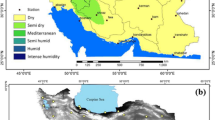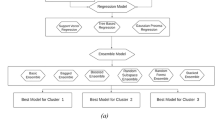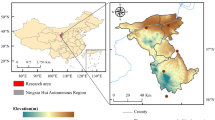Abstract
This study evaluates the future climate fluctuations in Iran’s eight major climate regions (G1–G8). Synoptic data for the period 1995–2014 was used as the reference for downscaling and estimation of possible alternation of precipitation, maximum and minimum temperature in three future periods, near future (2020–2040), middle future (2040–2060), and far future (2060–2080) for two shared socioeconomic pathways (SSP) scenarios, SSP119 and SSP245. The Gradient Boosting Regression Tree (GBRT) ensemble algorithm has been utilized to implement the downscaling model. Pearson’s correlation coefficient (CC) was used to assess the ability of CMIP6 global climate models (GCMs) in replicating observed precipitation and temperature in different climate zones for the based period (1995–2014) to select the most suitable GCM for Iran. The suitability of 21 meteorological variables was evaluated to select the best combination of inputs to develop the GBRT downscaling model. The results revealed GFDL-ESM4 as the most suitable GCM for replicating the synoptic climate of Iran for the base period. Two variables, namely sea surface temperature (ts) and air temperature (tas), are the most suitable variable for developing a downscaling model for precipitation, while ts, tas, and geopotential height (zg) for maximum temperature, and tas, zg, and sea level pressure (psl) for minimum temperature. The GBRT showed significant improvement in downscaling GCM simulation compared to support vector regression, previously found as most suitable for the downscaling climate in Iran. The projected precipitation revealed the highest increase in arid and semi-arid regions (G1) by an average of 144%, while a declination in the margins of the Caspian Sea (G8) by −74%. The projected maximum temperature showed an increase up to +8°C in highland climate regions. The minimum temperature revealed an increase up to +4°C in the Zagros mountains and decreased by −4°C in different climate zones. The results indicate the potential of the GBRT ensemble machine learning model for reliable downscaling of CMIP6 GCMs for better projections of climate.










Similar content being viewed by others
Data Availability
Please contact the corresponding author for data requests.
References
Abbasnia M, Toros H (2016) Future changes in maximum temperature using the statistical downscaling model (SDSM) at selected stations of Iran. Model Earth Syst Environ 2:68
Abdellatif M, Atherton W, Alkhaddar R (2013) A hybrid generalised linear and Levenberg–Marquardt artificial neural network approach for downscaling future rainfall in North Western England. Hydrol Res 44:1084–1101
Ahmed K, Sachindra DA, Shahid S et al (2020) Multi-model ensemble predictions of precipitation and temperature using machine learning algorithms. Atmos Res 236:104806
Ahmed K, Shahid S, Bin HS, Xiao-Jun W (2015) Multilayer perceptron neural network for downscaling rainfall in arid region: a case study of Baluchistan, Pakistan. J Earth Syst Sci 124:1325–1341
Ahmed K, Shahid S, Nawaz N, Khan N (2019) Modeling climate change impacts on precipitation in arid regions of Pakistan: a non-local model output statistics downscaling approach. Theor Appl Climatol 137:1347–1364
Alamgir M, Khan N, Shahid S et al (2020) Evaluating severity–area–frequency (SAF) of seasonal droughts in Bangladesh under climate change scenarios. Stoch Environ Res Risk Assess:1–18
Amnuaylojaroen T, Chanvichit P (2019) Projection of near-future climate change and agricultural drought in Mainland Southeast Asia under RCP8. 5. Clim Change 155:175–193
Asadollah SBHS, Sharafati A, Motta D, Yaseen ZM (2021) River water quality index prediction and uncertainty analysis: a comparative study of machine learning models. J Environ Chem Eng 9:104599
Azad A, Manoochehri M, Kashi H et al (2019) Comparative evaluation of intelligent algorithms to improve adaptive neuro-fuzzy inference system performance in precipitation modelling. J Hydrol 571:214–224
Baghanam AH, Eslahi M, Sheikhbabaei A, Seifi AJ (2020) Assessing the impact of climate change over the northwest of Iran: an overview of statistical downscaling methods. Theor Appl Climatol 141:1135–1150
Balaji V, Taylor KE, Juckes M et al (2018) Requirements for a global data infrastructure in support of CMIP6. Geosci Model Dev 11:3659–3680
Bellenger H, Guilyardi É, Leloup J et al (2014) ENSO representation in climate models: From CMIP3 to CMIP5. Clim Dyn 42:1999–2018
Bi D, Dix M, Marsland S et al (2020) Configuration and spin-up of ACCESS-CM2, the new generation Australian Community Climate and Earth System Simulator Coupled Model. J South Hemisph Earth Syst Sci 70:225–251
Cai J, Xu K, Zhu Y et al (2020) Prediction and analysis of net ecosystem carbon exchange based on gradient boosting regression and random forest. Appl Energy 262:114566
Cao J, Wang B, Yang Y-M et al (2018) The NUIST Earth System Model (NESM) version 3: description and preliminary evaluation. Geosci Model Dev 11:2975–2993
Dhamodaran S, Lakshmi M (2021) Comparative analysis of spatial interpolation with climatic changes using inverse distance method. J Ambient Intell Humaniz Comput 12:6725–6734
Dong X, Jin J, Liu H et al (2021) CAS-ESM2. 0 Model Datasets for the CMIP6 Ocean Model Intercomparison Project Phase 1 (OMIP1). Adv Atmos Sci 38:307–316
Doulabian S, Golian S, Toosi AS, Murphy C (2021) Evaluating the effects of climate change on precipitation and temperature for Iran using RCP scenarios. J Water Clim Chang 12:166–184
Duhan D, Pandey A (2015) Statistical downscaling of temperature using three techniques in the Tons River basin in Central India. Theor Appl Climatol 121:605–622
Eden SK, Li C, Shepherd BE (2021) Nonparametric estimation of Spearman’s rank correlation with bivariate survival data. Biometrics
Eyring V, Bony S, Meehl GA et al (2015) Overview of the Coupled Model Intercomparison Project Phase 6 (CMIP6) experimental design and organisation. Geosci Model Dev Discuss 8
Fallah-Ghalhari G, Shakeri F, Dadashi-Roudbari A (2019) Impacts of climate changes on the maximum and minimum temperature in Iran. Theor Appl Climatol 138:1539–1562
Friedman JH (2002) Stochastic gradient boosting. Comput Stat Data Anal 38:367–378
Goyal MK, Ojha CSP (2012) Downscaling of surface temperature for lake catchment in an arid region in India using linear multiple regression and neural networks. Int J Climatol 32:552–566
Guangqing Z, Yunquan Z, Jinrong J et al (2020) Earth system model: CAS-ESM. Front Data Comput 2:38–54
Hashimoto H, Wang W, Melton FS et al (2019) High-resolution mapping of daily climate variables by aggregating multiple spatial data sets with the random forest algorithm over the conterminous United States. Int J Climatol 39:2964–2983
Hastie T, Tibshirani R, Friedman J (2009) The elements of statistical learning: data mining, inference, and prediction. Springer Science & Business Media
Hewer MJ, Gough WA (2018) Thirty years of assessing the impacts of climate change on outdoor recreation and tourism in Canada. Tour Manag Perspect 26:179–192. https://doi.org/10.1016/J.TMP.2017.07.003
Kaufman L, Rousseeuw PJ (1990) Partitioning around medoids (program pam). Find groups data an Introd to Clust Anal:68–125
Kisi O, Choubin B, Deo RC, Yaseen ZM (2019) Incorporating synoptic-scale climate signals for streamflow modelling over the Mediterranean region using machine learning models. Hydrol Sci J 64:1240–1252
Krasting JP, John JG, Blanton C, et al (2018) Noaa-gfdl gfdl-esm4 model output prepared for cmip6 cmip historical. URL https//doi org/1022033/ESGF/CMIP6 8597:
Li L-L, Zhao X, Tseng M-L, Tan RR (2020) Short-term wind power forecasting based on support vector machine with improved dragonfly algorithm. J Clean Prod 242:118447
Li Q, Chen Y, Shen Y et al (2011) Spatial and temporal trends of climate change in Xinjiang, China. J Geogr Sci 21:1007–1018
Lima AR, Cannon AJ, Hsieh WW (2012) Downscaling temperature and precipitation using support vector regression with evolutionary strategy. In: The 2012 international joint conference on neural networks (IJCNN). IEEE, pp 1–8
Lu Y, Qin XS (2014) A coupled K-nearest neighbour and Bayesian neural network model for daily rainfall downscaling. Int J Climatol 34:3221–3236
LUO N, GUO Y, GAO Z et al (2020) Assessment of CMIP6 and CMIP5 model performance for extreme temperature in China. Atmos Ocean Sci Lett 13:589–597
Masoudi M (2021) Estimation of the spatial climate comfort distribution using tourism climate index (TCI) and inverse distance weighting (IDW)(case study: Fars Province, Iran). Arab J Geosci 14:1–13
Meehl GA, Boer GJ, Covey C et al (2000) The coupled model intercomparison project (CMIP). Bull Am Meteorol Soc 81:313–318
Modarres R (2006) Regional precipitation climates of Iran. J Hydrol 45
Moghim S, Bras RL (2017) Bias correction of climate modeled temperature and precipitation using artificial neural networks. J Hydrometeorol 18:1867–1884
Navarro-Racines C, Tarapues J, Thornton P et al (2020) High-resolution and bias-corrected CMIP5 projections for climate change impact assessments. Sci data 7:1–14
Nguyen PT, Ha DH, Jaafari A et al (2020) Groundwater potential mapping combining artificial neural network and real AdaBoost ensemble technique: the DakNong Province case-study, Vietnam. Int J Environ Res Public Health 17:2473
Nourani V, Baghanam AH, Gokcekus H (2018) Data-driven ensemble model to statistically downscale rainfall using nonlinear predictor screening approach. J Hydrol 565:538–551. https://doi.org/10.1016/J.JHYDROL.2018.08.049
Nourani V, Paknezhad NJ, Sharghi E, Khosravi A (2019a) Estimation of prediction interval in ANN-based multi-GCMs downscaling of hydro-climatologic parameters. J Hydrol 579:124226
Nourani V, Razzaghzadeh Z, Baghanam AH, Molajou A (2019b) ANN-based statistical downscaling of climatic parameters using decision tree predictor screening method. Theor Appl Climatol 137:1729–1746
O’Neill BC, Kriegler E, Ebi KL et al (2017) The roads ahead: narratives for shared socioeconomic pathways describing world futures in the 21st century. Glob Environ Chang 42:169–180
O’Neill BC, Kriegler E, Riahi K et al (2014) A new scenario framework for climate change research: the concept of shared socioeconomic pathways. Clim Change 122:387–400
Okkan U, Inan G (2015) Bayesian learning and relevance vector machines approach for downscaling of monthly precipitation. J Hydrol Eng 20:4014051
Okkan U, Kirdemir U (2016) Downscaling of monthly precipitation using CMIP5 climate models operated under RCPs. Meteorol Appl 23:514–528
Ozelkan E, Bagis S, Ozelkan EC et al (2015) Spatial interpolation of climatic variables using land surface temperature and modified inverse distance weighting. Int J Remote Sens 36:1000–1025
Pang B, Yue J, Zhao G, Xu Z (2017) Statistical downscaling of temperature with the random forest model. Adv Meteorol 2017
Pedregosa F, Varoquaux G, Gramfort A et al (2011) Scikit-learn: machine learning in Python. J Mach Learn Res 12:2825–2830
Pour SH, Abd Wahab AK, Shahid S (2020) Physical-empirical models for prediction of seasonal rainfall extremes of Peninsular Malaysia. Atmos Res 233:104720
Pour SH, Bin HS, Shahid S (2014) Genetic programming for the downscaling of extreme rainfall events on the East Coast of Peninsular Malaysia. Atmosphere (Basel) 5:914–936
Pour SH, Shahid S, Chung E-S, Wang X-J (2018) Model output statistics downscaling using support vector machine for the projection of spatial and temporal changes in rainfall of Bangladesh. Atmos Res 213:149–162
Rahimi J, Laux P, Khalili A (2020) Assessment of climate change over Iran: CMIP5 results and their presentation in terms of Köppen–Geiger climate zones. Theor Appl Climatol 141:183–199
Riahi K, Van Vuuren DP, Kriegler E et al (2017) The shared socioeconomic pathways and their energy, land use, and greenhouse gas emissions implications: an overview. Glob Environ Chang 42:153–168
Sa’adi Z, Shahid S, Chung E-S, bin Ismail T (2017) Projection of spatial and temporal changes of rainfall in Sarawak of Borneo Island using statistical downscaling of CMIP5 models. Atmos Res 197:446–460
Saboohi R, Soltani S, Khodagholi M (2012) Trend analysis of temperature parameters in Iran. Theor Appl Climatol 109:529–547
Sachindra DA, Ahmed K, Rashid MM et al (2018) Statistical downscaling of precipitation using machine learning techniques. Atmos Res 212:240–258
Salimi AH, Masoompour Samakosh J, Sharifi E et al (2019) Optimized artificial neural networks-based methods for statistical downscaling of gridded precipitation data. Water 11:1653
Samanta S, Pal DK, Lohar D, Pal B (2012) Interpolation of climate variables and temperature modeling. Theor Appl Climatol 107:35–45
Sanikhani H, Deo RC, Samui P et al (2018) Survey of different data-intelligent modeling strategies for forecasting air temperature using geographic information as model predictors. Comput Electron Agric 152:242–260
Seneviratne SI, Hauser M (2020) Regional climate sensitivity of climate extremes in CMIP6 versus CMIP5 multimodel ensembles. Earth’s Futur 8:e2019EF001474
Sha J, Li X, Wang Z-L (2019) Estimation of future climate change in cold weather areas with the LARS-WG model under CMIP5 scenarios. Theor Appl Climatol:1–13. https://doi.org/10.1007/s00704-019-02781-4
Sharafati A, Asadollah SBHS, Neshat A (2020) A new artificial intelligence strategy for predicting the groundwater level over the Rafsanjan aquifer in Iran. J Hydrol 591:125468
Sharafati A, Pezeshki E (2020) A strategy to assess the uncertainty of a climate change impact on extreme hydrological events in the semi-arid Dehbar catchment in Iran. Theor Appl Climatol 139:389–402
Song HY, Park S (2020) An analysis of correlation between personality and visiting place using Spearman’s rank correlation coefficient. KSII Trans Internet Inf Syst 14:1951–1966
Sospedra-Alfonso R, Merryfield WJ, Boer GJ et al (2021) Decadal climate predictions with the Canadian Earth System Model version 5 (CanESM5). Geosci Model Dev Discuss:1–52
Swart NC, Cole JNS, Kharin VV et al (2019) The Canadian earth system model version 5 (CanESM5. 0.3). Geosci Model Dev 12:4823–4873
Taylor KE, Stouffer RJ, Meehl GA (2012) An overview of CMIP5 and the experiment design. Bull Am Meteorol Soc 93:485–498
Tran Anh D, Van SP, Dang TD, Hoang LP (2019) Downscaling rainfall using deep learning long short-term memory and feedforward neural network. Int J Climatol 39:4170–4188
Wei L, Yuan Z, Zhong Y et al (2019a) An improved Gradient Boosting Regression Tree estimation model for soil heavy metal (arsenic) pollution monitoring using hyperspectral remote sensing. Appl Sci 9:1943
Wei Z, Meng Y, Zhang W et al (2019b) Downscaling SMAP soil moisture estimation with gradient boosting decision tree regression over the Tibetan Plateau. Remote Sens Environ 225:30–44
Wilby R, Dawson C, Barrow E (2002) sdsm — a decision support tool for the assessment of regional climate change impacts. Environ Model Softw 17:145–157. https://doi.org/10.1016/S1364-8152(01)00060-3
Wu T, Zhang F, Zhang J et al (2020a) Beijing Climate Center Earth System Model version 1 (BCC-ESM1): model description and evaluation of aerosol simulations. Geosci Model Dev 13:977–1005
Wu Y, Ke Y, Chen Z et al (2020b) Application of alternating decision tree with AdaBoost and bagging ensembles for landslide susceptibility mapping. Catena 187:104396
Xiao C, Chen N, Hu C et al (2019) Short and mid-term sea surface temperature prediction using time-series satellite data and LSTM-AdaBoost combination approach. Remote Sens Environ 233:111358
Xin X, Wu T, Zhang J et al (2020) Comparison of CMIP6 and CMIP5 simulations of precipitation in China and the East Asian summer monsoon. Int J Climatol 40:6423–6440
Yang Y-M, Wang B, Cao J, et al (2020) Improved historical simulation by enhancing moist physical parameterizations in the climate system model NESM3. 0. Clim Dyn 54:
Yazdandoost F, Moradian S, Izadi A, Aghakouchak A (2021) Evaluation of CMIP6 precipitation simulations across different climatic zones: uncertainty and model intercomparison. Atmos Res 250:105369
Zamani Y, Monfared SAH, Hamidianpour M (2020) A comparison of CMIP6 and CMIP5 projections for precipitation to observational data: the case of Northeastern Iran. Theor Appl Climatol 142:1613–1623
Zhang J, Wu T, Zhang F et al (2021) BCC-ESM1 Model Datasets for the CMIP6 Aerosol Chemistry Model Intercomparison Project (AerChemMIP). Adv Atmos Sci 38:317–328
Zhou T, He L, Wu J et al (2019) Prediction of surface roughness of 304 stainless steel and multi-objective optimization of cutting parameters based on GA-GBRT. Appl Sci 9:3684
Acknowledgements
The authors would like to reveal their gratitude and appreciation to the Iranian Meteorological Organization and Iran Water Resources Management Company for providing data.
Code availability
Please contact the corresponding author for code requests.
Author information
Authors and Affiliations
Contributions
Seyed Babak Haji Seyed Asadollah carried out the review analysis and modeling and participated in drafting the manuscript. Ahmad Sharafati proposed the topic, participated in coordination, and aided in interpreting results and paper editing. Shamsuddin Shahid carried out the investigation and paper editing. All authors read and approved the final manuscript.
Corresponding author
Ethics declarations
Ethics approval
Not applicable.
Consent to participate
Not applicable.
Consent for publication
Not applicable.
Competing interests
The authors declare no competing interests.
Additional information
Responsible Editor: Marcus Schulz
Publisher’s note
Springer Nature remains neutral with regard to jurisdictional claims in published maps and institutional affiliations.
Rights and permissions
About this article
Cite this article
Asadollah, S.B.H.S., Sharafati, A. & Shahid, S. Application of ensemble machine learning model in downscaling and projecting climate variables over different climate regions in Iran. Environ Sci Pollut Res 29, 17260–17279 (2022). https://doi.org/10.1007/s11356-021-16964-y
Received:
Accepted:
Published:
Issue Date:
DOI: https://doi.org/10.1007/s11356-021-16964-y




